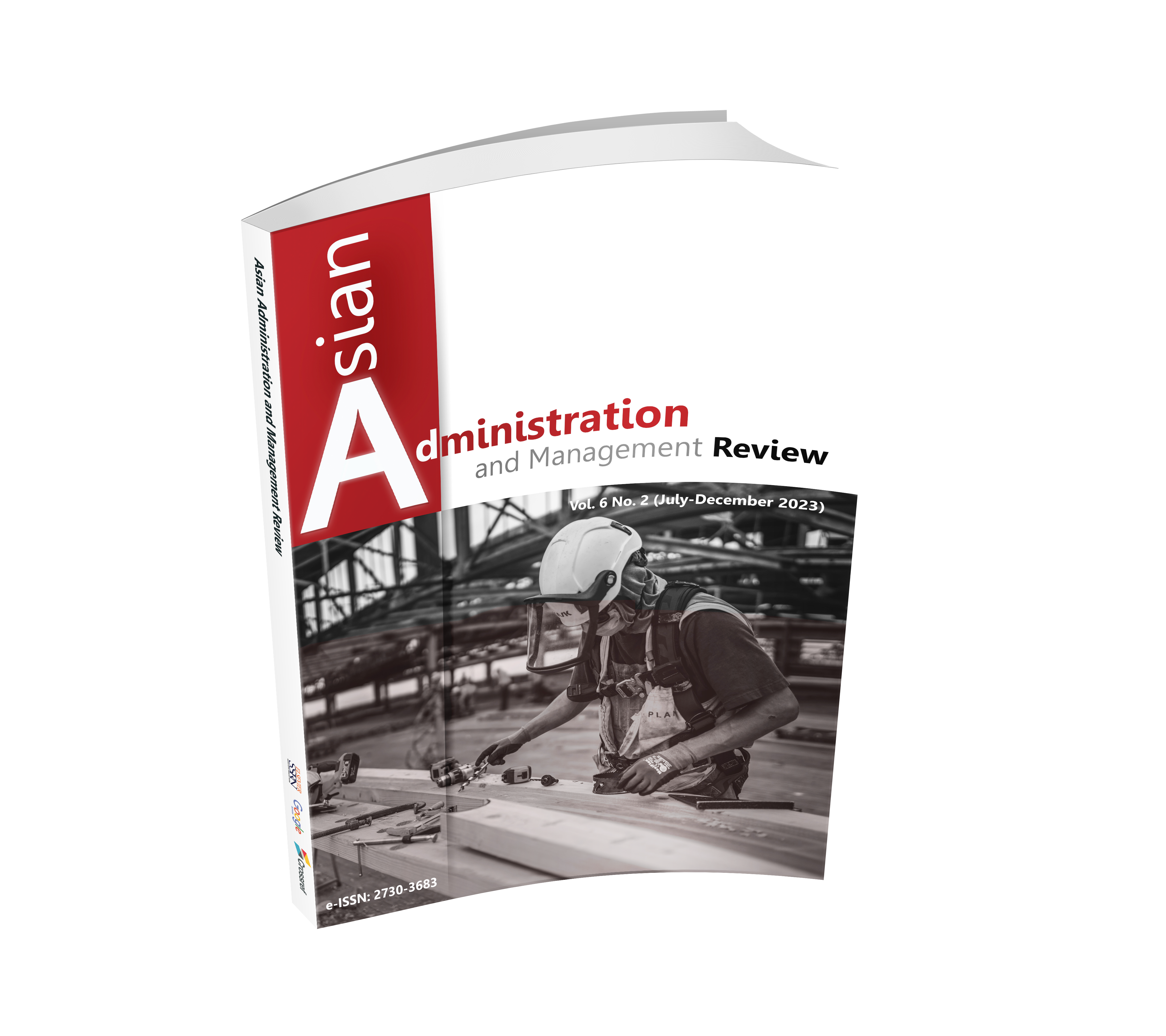SMART LOGISTICS 5.0 TRANSFORMATION STRATEGY APPLIED TO BRIDGING THE ANALYTICS HIERARCHY PROCESS AND DISRUPTION INTELLIGENCE INVENTORY MANAGEMENT TRENDS
DOI:
https://doi.org/10.14456/aamr.2023.13Keywords:
Logistics 5.0, Analytics Hierarchy Process Alternatives, Disruption Intelligence, Inventory Management, Smart Transformation StrategyAbstract
As smart transformation strategy to bridge the model of the implementation of logistics 5.0 in small medium-sized enterprises, the analytics hierarchy process and disruption intelligence goals have been highlighted. Therefore, the goal of this research is to bridge the analytics hierarchy process of the logistics 5.0 implementation model to the disruption intelligence goals. The results showed that based on the analytics hierarchy method applied to the analytics hierarchy process of the logistics 5.0 implementation model raised that concerned about 5 group elements of the analytics hierarchy alternatives consisted of about 5 group elements of the analytics hierarchy a alternatives consisted of infrastructure, organization and human resources as well as green logistics, which are divided into three components, green packaging, green warehousing, and green transport. By bridging the disruption intelligence inventory management trends, these results establish logistics 5.0 in terms of smart transformation strategy.
Downloads
References
Accenture. (2021). Fast-track to Future-Ready Performance. Retrieved from www.accenture.com/content/dam/accenture/final/a-com-migration/custom/_acnmedia/thought-leadership-assets/pdf-4/Accenture-Future-Ready-Operations-POV.pdf.
Aoun, J., Quaglietta, E., Goverde, R., Scheidt, M., Blumenfeld, M., Jack, A., & Redfern, B. (2021). A hybrid Delphi-AHP multi-criteria analysis of moving block and virtual coupling railway signalling. Transportation Research Part C: Emerging Technologies, 129, 103250.
Becerra, P., Mula, J., & Sanchis, R. (2022). Sustainable Inventory Management in Supply Chains: Trends and Further Research. Sustainability, 14(5), 2613.
Bhargava, A., Bhargava, D., Kumar, P., Sajja, G., & Ray, S. (2022). Industrial IoT and AI implementation in vehicular logistics and supply chain management for vehicle mediated transportation systems. International Journal of System Assurance Engineering and Management, 13, 673-680.
Brzezinski, L., & Wyrwicka, M. (2022). The Progress of Digitalization of Logistics Management in the Enterprise Caused by the COVID-19 Pandemic. European Research Studies Journal, 25(2B), 94-105.
Canco, I., Kruja, D., & Iancu, T. (2021). AHP, a Reliable Method for Quality Decision Making: A Case Study in Business. Sustainability, 13(24), 13932.
Craighead, C., Ketchen Jr., D., & Darby, J. (2020). Pandemics and Supply Chain Management Research: Toward a Theoretical Toolbox. Decision Science, 51(4), 838-866.
Deutsche Post DHL. (2012). Annual Report 2012 Pioneering Future Markets. Retrieved from www.annualreports.com/HostedData/AnnualReportArchive/d/OTC_DPSGY_2012.pdf.
El-Berishy, N., Rugge, I., & Scholz-Reiter, B. (2013). The Interrelation between Sustainability and Green Logistics. IFAC Proceedings Volumes, 46(24), 527-531.
Figueiras, P., Lourenco, L., Costa, R., Graca, D., Garcia, G., & Jardim-Goncalves, R. (2021). Big Data Provision for Digital Twins in Industry 4.0 Logistics Processes. A paper presented at the 2021 IEEE International Workshop on Metrology for Industry 4.0 and IoT, Rome, Italy.
Friedman, M. (1940). A Comparison of Alternative Tests of Significance for the Problem of m Rankings. The Annals of Mathematical Statistics, 11(1), 86-92.
Gultekin, B., Demir, S., Gunduz, M., Cura, F., & Ozer, L. (2022). The logistics service providers during the COVID-19 pandemic: The prominence and the cause-effect structure of uncertainties and risks. Computers & Industrial Engineering, 165, 107950.
Ivey, A., & Ivey, M. (2008). Essentials of Intentional Interviewing: Counselling in a Multicultural World. Massachusetts: Thomson Brooks/Cole.
Jafari, N., Azarian, M., & Yu, H. (2022). Moving from Industry 4.0 to Industry 5.0: What Are the Implications for Smart Logistics?. Logistics, 6(2), 26.
Kim, W., & Mauborgne, R. (2015). Blue Ocean Strategy, Expanded Edition: How to Create Uncontested Market Space and Make the Competition Irrelevant. Massachusetts: Harvard Business Review Press.
Klein, M., Gutowska, E., & Gutowski, P. (2022). Innovations in the T&L (Transport and Logistics) Sector during the COVID-19 Pandemic in Sweden, Germany and Poland. Sustainability, 14(6), 3323.
Liu, W., Bai, E., Liu, L., & Wei, W. (2017). A Framework of Sustainable Service Supply Chain Management: A Literature Review and Research Agenda. Sustainability, 9(3), 421.
Machado, H. (2016). Growth of small businesses: A literature review and perspectives of studies. Gestão & Produção, 23(2), 419-432.
Macmillan, T. (1971). The Delphi Technique. A paper presented at the Annual Meeting of the California Junior Colleges Associations Committee on Research and Development, Monterey, USA.
Mashayekhy, Y., Babaei, A., Yuan, X., & Xue, A. (2022). Impact of Internet of Things (IoT) on Inventory Management: A Literature Survey. Logistics, 6(2), 33.
Opetuk, T. (2016). Model of green supply chain management implementation. Doctoral Thesis, University of Zagreb.
Ozkanlisoy, O. (2021). The COVID-19 outbreak’s effects and new inclinations in terms of logistics and supply chain activities: A conceptual framework. Journal of Management, Marketing and Logistics, 8(2), 76-88.
Queiroz, M., Ivanov, D., Dolgui, A., & Wamba, S. (2022). Impacts of epidemic outbreaks on supply chains: mapping a research agenda amid the COVID-19 pandemic through a structured literature review. Annals of Operations Research, 319, 1159-1196.
Roughan, G. (2021). 10 inventory management trends to watch for in 2023. Retrieved from www.unleashedsoftware.com/blog/the-10 inventory-management-trends-to-watch-for-in-2022.
Saaty, T. (1988). What Is the Analytic Hierarchy Process?. Baden-Württemberg: Springer.
Sasananan, M., Narkhede, B., Gardas, B., & Raut, R. (2016). Selection of Third Party Logistics Service Provider Using a Multi-Criteria Decision Making Approach for Indian Cement Manufacturing Industries. Thammasat International Journal of Science and Technology, 21(3), 70-81.
Sgarbossa, F., Grosse, E., Neumann, W., Battini, D., & Glock, C. (2020). Human factors in production and logistics systems of the future. Annual Reviews in Control, 49, 295-305.
Sharma, M. (n.d.). Intelligent operations for future-ready businesses. Retrieved from www.accenture.com/dk-en/insights/operations/future-ready-operations.
Swanson, D., & Santamaria, L. (2021). Pandemic Supply Chain Research: A Structured Literature Review and Bibliometric Network Analysis. Logistics, 51(1), 7.
Trstenjak, M., Opetuk, T., Dukic, G., & Cajner, H. (2022). Logistics 5.0 Implementation Model Based on Decision Support Systems. Sustainability, 14(11), 6514.
Urquhart, C., Lehmann, H., & Myers, M. (2010). Putting the ‘theory’ back into grounded theory: guidelines for grounded theory studies in information systems. Information Systems Journal, 20(4), 357-381.
Winkelhaus, S., & Grosse, E. (2020). Logistics 4.0: A systematic review towards a new logistics system. International Journal of Production Research, 58(1), 18-43.
Zhang, G., & Zhao, Z. (2012). Green Packaging Management of Logistics Enterprises. Physics Procedia, 24(B), 900-905.
Zhong, B., Luo, W., Li, H., Zhang, Q., Liu, X., Li, W., & Li, Y. (2020). Knowledge, attitudes, and practices towards COVID-19 among Chinese residents during the rapid rise period of the COVID-19 outbreak: a quick online cross-sectional survey. International Journal of Biological Sciences, 16(10), 1745-1752.

Downloads
Published
How to Cite
Issue
Section
License
Copyright (c) 2023 Authors

This work is licensed under a Creative Commons Attribution-NonCommercial-NoDerivatives 4.0 International License.











.png)


